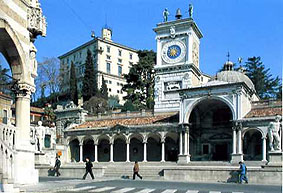


All the structures

Udine, a province of Friuli, has a wonderful, mainly medieval town centre that can be explored on foot.
A walk will take you to the Castle, built in 1517 on the remains of a previous defensive structure. The castle is now the headquarters of the city’s major museums: the Civic Museum, the Archaeological Museum and the Art Gallery. In Udine Cathedral you can admire frescoes by the Venetian painter Giovanbattista Tiepolo (1696-1770), one of the major representatives of Baroque painting.
Udine provides the opportunity of visiting one of Italy’s most beautiful town squares: the Renaissance Piazza della Libertà. Situated at the foot of the castle, the main square has a particularly animated appearance, mostly due to the irregular lie of the land. The uneven site necessitated building the main square on various levels linked by stairs, which gives it a very dramatic appearance.
Worth visiting in Udine province is Fagangna, the town of storks. The name Fagagna derives from the numerous beech trees (faggi) in the woods that cover this area. The town is composed of seven villages joined by urban development over the course of years. Fagagna is known for its famous cheese. This tasty delicacy is produced solely from fresh, unpasteurized milk.
Another wonderful village in Udine province is Clauiano, which has many seventeenth and eighteenth-century buildings that are typically Friulian with internal courtyards.
Palmanova was built in 1593 to defend the Venetian Republic from a possible attack by the Turks. It was designed as a proper city barely one kilometre in diameter, however the attack by the Turks never took place. Piazza Grande, the main square, has a hexagonal form and contains the Cathedral built in 1602. Inside is the Militia altarpiece, a work by Padovanino from 1642.